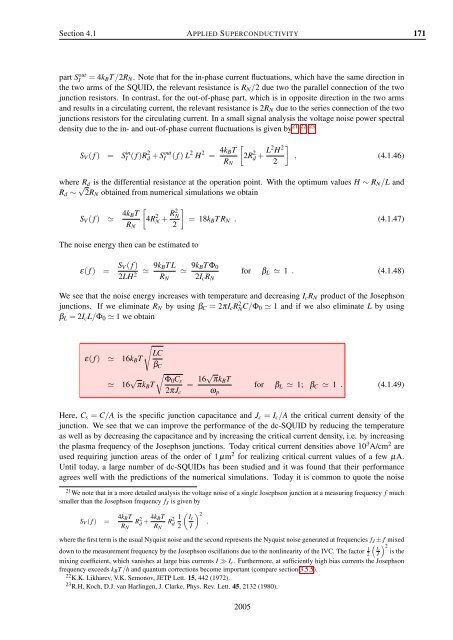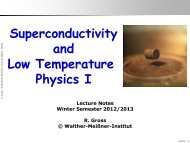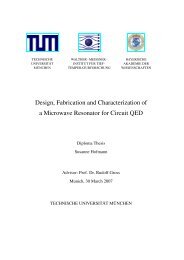Applied Superconductivity - Walther Meißner Institut - Bayerische ...
Applied Superconductivity - Walther Meißner Institut - Bayerische ...
Applied Superconductivity - Walther Meißner Institut - Bayerische ...
- No tags were found...
Create successful ePaper yourself
Turn your PDF publications into a flip-book with our unique Google optimized e-Paper software.
Section 4.1 APPLIED SUPERCONDUCTIVITY 171part SIout = 4k B T /2R N . Note that for the in-phase current fluctuations, which have the same direction inthe two arms of the SQUID, the relevant resistance is R N /2 due two the parallel connection of the twojunction resistors. In contrast, for the out-of-phase part, which is in opposite direction in the two armsand results in a circulating current, the relevant resistance is 2R N due to the series connection of the twojunctions resistors for the circulating current. In a small signal analysis the voltage noise power spectraldensity due to the in- and out-of-phase current fluctuations is given by 21,22,23S V ( f ) = SI in ( f )R 2 d + SIout ( f ) L 2 H 2 = 4k [BT2R 2 d + L2 H 2 ]R N 2, (4.1.46)where R d is the differential resistance at the operation point. With the optimum values H ∼ R N /L andR d ∼ √ 2R N obtained from numerical simulations we obtainS V ( f ) ≃ 4k [ ]BT4R 2 N + R2 NR N 2The noise energy then can be estimated to= 18k B T R N . (4.1.47)ε( f ) = S V ( f )2LH 2≃ 9k BT LR N≃ 9k BT Φ 02I c R Nfor β L ≃ 1 . (4.1.48)We see that the noise energy increases with temperature and decreasing I c R N product of the Josephsonjunctions. If we eliminate R N by using β C = 2πI c R 2 N C/Φ 0 ≃ 1 and if we also eliminate L by usingβ L = 2I c L/Φ 0 ≃ 1 we obtainε( f ) ≃ 16k B T≃√LCβ C16 √ √Φ0 C sπk B T2πJ c= 16√ πk B Tω pfor β L ≃ 1; β C ≃ 1 . (4.1.49)Here, C s = C/A is the specific junction capacitance and J c = I c /A the critical current density of thejunction. We see that we can improve the performance of the dc-SQUID by reducing the temperatureas well as by decreasing the capacitance and by increasing the critical current density, i.e. by increasingthe plasma frequency of the Josephson junctions. Today critical current densities above 10 3 A/cm 2 areused requiring junction areas of the order of 1 µm 2 for realizing critical current values of a few µA.Until today, a large number of dc-SQUIDs has been studied and it was found that their performanceagrees well with the predictions of the numerical simulations. Today it is common to quote the noise21 We note that in a more detailed analysis the voltage noise of a single Josephson junction at a measuring frequency f muchsmaller than the Josephson frequency f J is given byS V ( f ) = 4k BTR NR 2 d + 4k BTR NR 2 d( )1 2 Ic,2 Iwhere the first term is the usual Nyquist noise and the second represents the Nyquist noise generated at frequencies f J ± f mixeddown to the measurement frequency by the Josephson oscillations due to the nonlinearity of the IVC. The factor 1 2( IcI) 2is themixing coefficient, which vanishes at large bias currents I ≫ I c . Furthermore, at sufficiently high bias currents the Josephsonfrequency exceeds k B T /h and quantum corrections become important (compare section 3.5.5).22 K.K. Likharev, V.K. Semonov, JETP Lett. 15, 442 (1972).23 R.H. Koch, D.J. van Harlingen, J. Clarke, Phys. Rev. Lett. 45, 2132 (1980).2005
















